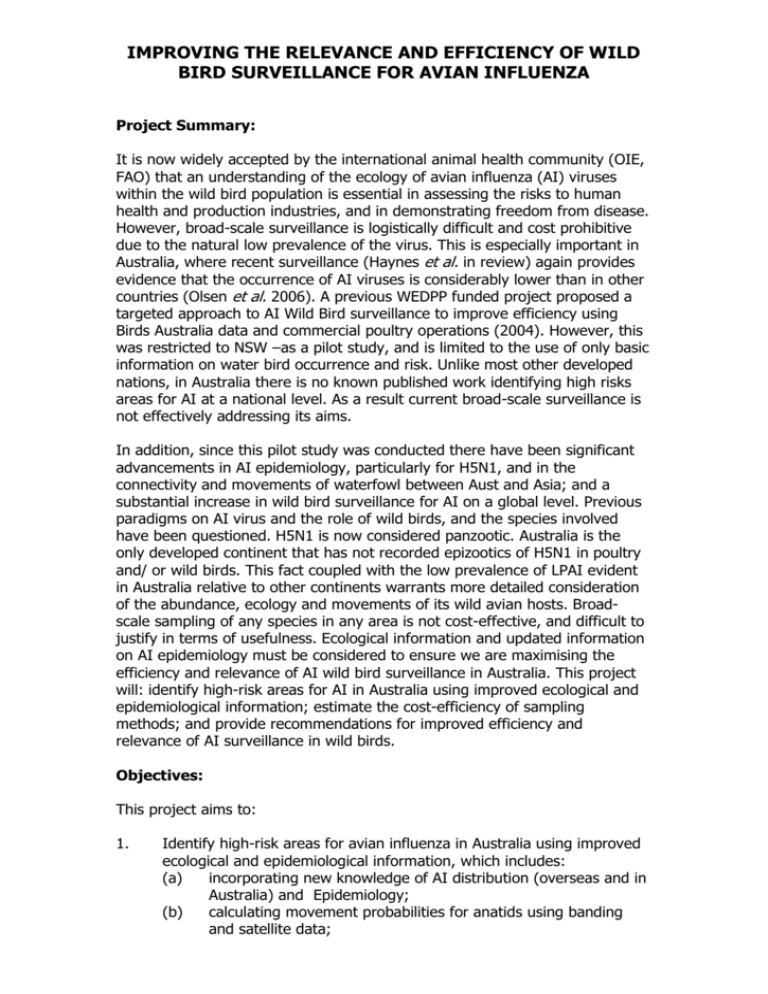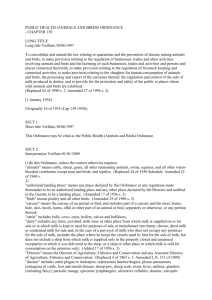Improving the Relevance And Efficiency Of Wild Bird Surveillance for
advertisement

IMPROVING THE RELEVANCE AND EFFICIENCY OF WILD BIRD SURVEILLANCE FOR AVIAN INFLUENZA Project Summary: It is now widely accepted by the international animal health community (OIE, FAO) that an understanding of the ecology of avian influenza (AI) viruses within the wild bird population is essential in assessing the risks to human health and production industries, and in demonstrating freedom from disease. However, broad-scale surveillance is logistically difficult and cost prohibitive due to the natural low prevalence of the virus. This is especially important in Australia, where recent surveillance (Haynes et al. in review) again provides evidence that the occurrence of AI viruses is considerably lower than in other countries (Olsen et al. 2006). A previous WEDPP funded project proposed a targeted approach to AI Wild Bird surveillance to improve efficiency using Birds Australia data and commercial poultry operations (2004). However, this was restricted to NSW –as a pilot study, and is limited to the use of only basic information on water bird occurrence and risk. Unlike most other developed nations, in Australia there is no known published work identifying high risks areas for AI at a national level. As a result current broad-scale surveillance is not effectively addressing its aims. In addition, since this pilot study was conducted there have been significant advancements in AI epidemiology, particularly for H5N1, and in the connectivity and movements of waterfowl between Aust and Asia; and a substantial increase in wild bird surveillance for AI on a global level. Previous paradigms on AI virus and the role of wild birds, and the species involved have been questioned. H5N1 is now considered panzootic. Australia is the only developed continent that has not recorded epizootics of H5N1 in poultry and/ or wild birds. This fact coupled with the low prevalence of LPAI evident in Australia relative to other continents warrants more detailed consideration of the abundance, ecology and movements of its wild avian hosts. Broadscale sampling of any species in any area is not cost-effective, and difficult to justify in terms of usefulness. Ecological information and updated information on AI epidemiology must be considered to ensure we are maximising the efficiency and relevance of AI wild bird surveillance in Australia. This project will: identify high-risk areas for AI in Australia using improved ecological and epidemiological information; estimate the cost-efficiency of sampling methods; and provide recommendations for improved efficiency and relevance of AI surveillance in wild birds. Objectives: This project aims to: 1. Identify high-risk areas for avian influenza in Australia using improved ecological and epidemiological information, which includes: (a) incorporating new knowledge of AI distribution (overseas and in Australia) and Epidemiology; (b) calculating movement probabilities for anatids using banding and satellite data; -2(c) (d) (e) predicting bird abundance using the number of species (Birds Australia data); reviewing behavioral traits, breeding behavior, distribution and movements of Australian water birds in relation to recorded prevalence of AI and their potential role as sentinel vs maintenance hosts of LPAI and HPAI; and produce maps of high risk areas using (a)-(c) to specifically address key questions, originally proposed by the AI Wild Bird Steering Group (Woods et al. 2005). 2. Estimate the cost-efficiency of sampling methods (wild bird mortalities, environmental sampling, trapping, netting, use of hunters, and PCR and virus isolation vs serology) with relevance to the likelihood of detection and usefulness of information obtained. 3. Provide recommendations for: (a) improved efficiency and relevance of AI surveillance in wild birds; and (b) sampling wild birds during an epizootic of AI in poultry.



